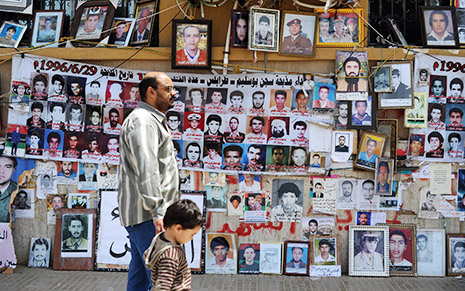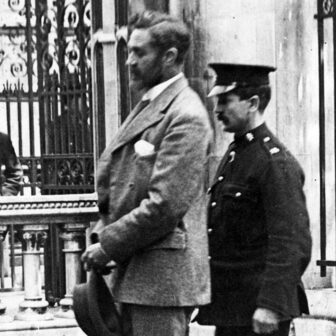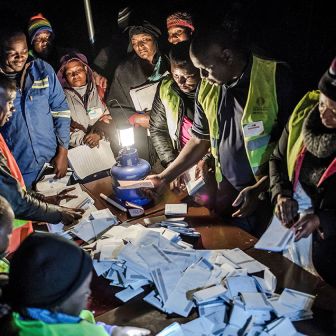I WAS late for the revolution. Nearly two months had passed by the time I crossed the border from Egypt to Libya and drove on to Benghazi, where the uprising against Muammar Gaddafi began in mid February. A sprawling, modern port city, Benghazi was under the full control of the revolutionaries, and far less tense than I had expected. The frequent bursts of gunfire marked either celebration or, as when a dead fighter was brought from the faraway frontline to the city’s courthouse, mourning. The explosions came from TNT “fishbombs” triggered by lazy fishermen taking advantage of the lack of government to boost their catches.
Many of the shops were open; the pizza was good and the seafood, fishbombed or not, was excellent. Coffee bars hinted at the Italian colonial rule, serving macchiatos and cappuccinos, though what Rome would make of the breakfast delicacy of cornflakes, hot milk and melted chocolate mixed together in a paper cup is anyone’s guess.
This is not to say that the city looked or functioned as before. In the coffee bars, as everywhere where a television was turned on, the usual fare of football had been replaced by the twenty-four-hour news from Al Jazeera. Out on the streets, numerous buildings affiliated to the Gaddafi regime were stained with black smoke. One afternoon I visited the remains of the vast military barracks and armoury, where the near-complete destruction wrought by the protesters spoke of their hatred of the regime that had ruled the country for forty-two years. But the soldiers had not gone down without a fight. Before they fled, or were killed, they had fired into the crowds of unarmed protesters using anti-aircraft guns. Some of the demonstrators were literally cut in half, as I saw from one photograph displayed on a “martyrs’ board.” Gaddafi had not just turned on his people when they demanded change, he had tried to destroy them.
Here in the east of Libya the revolt had quickly evolved into a desert war fought along the main road that leads to Tripoli. With its tanks and long-range missile launchers, the regime had the clear advantage. The armoury of the thowar – the civilian fighters – amounted to what they had been able to loot or capture. They had been innovative, though, mounting on the back of pickup trucks various heavy weapons, including large guns usually found on the sides of attack helicopters.
NATO’s no-fly zone had evened the battle, however, and on the morning I drove out to the frontline near the town of Ajdabiya the road was littered with burnt-out tanks, armoured personnel carriers and trucks that had been destroyed from the air before their drivers even realised they were under attack. In the early days of the fighting, journalists had been able to get close to the rebel fighters, and to the fighting. Now, though there were still clashes, they were mostly long-distance, each side shelling its largely invisible enemy.
For a journalist it was frustrating; I could see little of what was happening. I thought, with some foolish regret, that I had missed the best action of the war. But a different battle altogether was taking place in Misrata, a large city about 200 kilometres east of Tripoli – right in the heart of the territory that Gaddafi still controlled. Somehow, the people of Misrata had managed to repel everything the army had thrown at them for two months, despite being almost completely cut off. The only way in was by sea, so I caught a ferry that had been chartered to pick up migrant workers stranded in the city.
After nearly a day cruising the Mediterranean Sea – a surreal way to enter a war zone – the boat reached Misrata. The port was perhaps eight kilometres from the city, and it was only the frequent checkpoints manned by young male volunteers armed with AK-47s that hinted something was seriously wrong. Soon, though, I began to hear multiple explosions, and the bah-bah-bah-bah of heavy machine guns. These were not fishbombs or gunfire for celebration or mourning. This was war. And it was close. From the journalists’ “inn” – the basement gymnasium of a clinic where we were put up – we had only to drive for ten or fifteen minutes to the city centre to see a fierce battle taking place.
After Gaddafi’s troops forced their way into Misrata in March, using tanks and other armoured vehicles, many hundreds of loyalist snipers occupied the apartment and office blocks along Tripoli Street – the city’s tallest buildings along its main thoroughfare. From there the snipers could pick off anything that moved: civilians or volunteer fighters. And they did, as a quick visit to the town’s main hospital showed. In one ward lay a ten-year-old boy who had been shot in the head when he stepped outside his front door. Miraculously he’d survived, but he kept crying out incomprehensibly. His mother looked at him with a blank, devastated face, unable to find words.
I drove towards the city centre with two other journalists and a local man, who navigated slowly and carefully along side streets, eager not to expose us in danger. The destruction wrought by the conflict quickly became evident. Entire neighbourhoods bore the scars of conflict – burnt houses, the pockmarks of bullets and the more severe damage where shells and mortars had struck. There was evidence of guerilla tactics too: to stop Gaddafi’s tanks entire streets had been blocked with trucks, giant mounds of sand, or shipping containers filled with wet sand.
We reached a side road, close to Tripoli Street, where a unit of thowar were taking breakfast. They were mostly young men in their twenties – students, engineers and construction workers. “Normal people,” as one of them said. As they escorted us closer to Tripoli Street we could hear the bullets fizzing. Every now and then the thowar told us to run since we were in the snipers’ line of sight. The frustration of not being able to observe the war in the east had been replaced by the exhilaration of experiencing it at close quarters. And by fear. •




